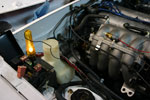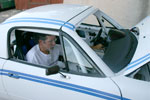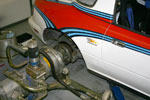| MIATA BUILD |
|
|
 |  |  | April 30, 2007 - Enough playing around with pretty valve covers, it's time to get back to work.
The fuel lines are hooked up and the engine bay is gradually being repopulated with wires, hoses and tanks. I made one little error here - the fuel injector harness is for a 1995-97 model car with the "three-wire" coils. But the main wiring harness is from a 1994 model with "four-wire" coils. Not a problem, I can run that way - but first I need to change a plug. Whoops.
Meanwhile, Jeremy at Flyin' Miata has prepared the base map for the ECU. It's pretty impressive, really. I told him I needed a base map for a high-compression 2.0 with 1999-00 injectors, the 1999 intake manifold with VICS, a front crank trigger from a 1996-05 with a cam angle sensor for TDC...and his question was "do you need A/C?"
entry 156 - tags: engine, interchange, tuning |  |  |  | May 15, 2007 - It's alive!
The car runs!
The trouble light shown here is being used as an oil pressure light to back up the gauge. The fuel injector fuse is removed so I can crank the engine (that poor little battery) and get pressure up. The test light went out at 7 psi and the analog gauge woke up shortly after.
Once oil pressure had been established, I powered up the ECU and connected the laptop to make sure all the sensors were sensing appropriately. A turn of the key and a bit of cranking as the fuel system filled - and then boom! The engine came to life. There's an exhaust leak somewhere (maybe I forgot to install something), but the engine revs sweetly. I only ran it for a few seconds before shutting down. I have a few other things to attend to right now (such as my wedding on Sunday), but a major milestone has been reached. There was much rejoicing!
entry 175 - tags: wiring, tuning |  |  | July 1, 2007 - I calibrated the wideband oxygen sensor today.
This has been holding me up because it needed to be wired in. Finally I just decided to get on with it, and it was a pretty straightforward procedure. So that's it for setting up the drivetrain. Now it's time to actually drive the car. I'll probably take it out of the garage for an extended drive on Wednesday, which is a holiday for some reason. It's also the third anniversary of the first drive of the Seven for a nice piece of symmetry. The Targa car is more complete than the Seven was at that point, though.
I hope.
entry 230 - tags: tuning, other cars |  |  |  | July 5, 2007 - Bill Cardell stopped by on the July 4th holiday to help me take the car for its first significant run.
We bolted on the hardtop, fixed a small brake leak at one wheel, set the timing and then headed out for a spin. The car did very well overall. The fuel and timing maps, based on a "best guess" by Jeremy at Flyin' Miata, are pretty close and the autotuning abilities of the Hydra Nemesis will take care of the former quite easily.
The car feels good. The engine comes on cam at about 4000 rpm and pulls strongly up to my self-imposed redline of 5500. I'll stretch the engine past that next time I go for a drive. The steering was surprisingly light even without the power steering belt installed, but I'll have that fixed soon. It's too early to say anything about the suspension as it's currently on junkyard parts. Brakes feel strong though. Overall, it's giving the impression of being a very promising, entertaining car.
It wasn't completely free of problems, of course. The temperature gauge on the dash isn't working, but that's an easy fix because it's a very simple system. I wired the fans off the same switch which seemed easier at the time, but having them staged makes more sense and takes a load off the wiring. The front tires rubbed on light corners but I think I have that sorted now by bending some mounting tabs for the inner fender liners. The lack of a windshield made the car fairly drafty as well.
Time for more driving! And then the masking for the new paint job.
entry 237 - tags: testing, tuning |  |  | August 14, 2007 - Ready for the track day.
Three years ago, my Seven made its public debut at the Flyin' Miata Open House as well as its first serious track testing. This year, it's the Targa Miata's turn. There's a lot of interest in the car so it's going to be fun.
For final preparation, Brandon and I bolted on a new right rear caliper to solve a problem with the handbrake sticking on. Hopefully the rotor will be okay, a coworker drove the car about 1/2 a mile today with the old caliper siezed tight in place. Stinky!
The engine tuning was given a bit of a tweak today as well. The engine isn't putting out full power, that's fairly obvious even if we didn't put the car on the dyno. Still, it should be safe to run on track and the engine is very eager and flexible. At least it will idle happily now!
And voila. A bit of cleanup for the interior and I'm ready. Just in time, too!
entry 292 - tags: testing, brakes, tuning |  |  |  | October 12, 2007 - Dyno time!
Now this was a frustrating day. Driving the car in to Flyin' Miata, I found I had a big vacuum leak. I'd folded the steel gasket between the two halves of the intake manifold while installing the VICS actuator. Thanks, Mazda, for making that one bolt so hard to access that I had to disassemble the intake! It's a good thing that FM keeps them in stock.
Once that was done, Jeremy at FM did a couple of pulls. He reported some pinging as the dyno was holding the car at 2000 rpm - a load situation that will never be seen in the real world, but still - and sorted that out, then blew coolant all over the shop. Turns out one of the fans had decided to stop working so the car got a bit hot and the radiator cap opened up. So, I spent some time fixing a remarkably recalcitrant wiring problem and also tracking down why the O2 sensor wasn't heating up properly.
It doesn't sound like much, but every time we had to stop it meant a couple of hours of delay before Jeremy was able to get back at the car. On top of that, it was obvious that the car needed a lot of dyno tuning, as the output was unspectacular. There's a big dip in the torque curve between 3000 and 4000 rpm, and the power tapers off dramatically just about 6000. Looking at a dyno chart of a similar engine, the bottom end is pretty good if you ignore a dip - but the top end prevents the big headline number from being very interesting. Because I needed the car to drive home, all the goofing around with other miscellaneous problems meant that we ran out of time. We established a baseline, that's all.
So what's wrong? Most likely the cam timing. This is an untested set of cams, and I'm not sure where they should be yet. The car will go back on the dyno shortly, and I'll do a lot of experimenting. I expect to pick up a fair bit of top end, hopefully without losing that nice spread of torque. I might also try another set of cams, the Webcam 505s that I'm running in my little 1.6 are quite impressive. Then it'll be time for a new, bigger header.
So, not the best day. But it's a start. I took the car for a spirited drive home last night, and it sure is fun to drive and seems awfully quick without any other cars around. Is it effective enough to keep up with some of the other cars at at the Targa? I don't know, that's why I need more from the engine, to give me a better tool to use!
entry 323 - tags: tuning, engine |  |  | February 29, 2008 - I did a bit of autotuning on the way in to work.
The long way, of course. After looking at the changes, it appears the engine is hungry for all sorts of extra fuel up top. This is excellent, as it implies the engine is making more power. Yay! The car should hit the dyno on Monday and then I'll know a bit more. Jeremy at Flyin' Miata took a look at the maps and massaged them somewhat, so I have a better starting point for more autotuning on the weekend.
I also discovered that the Coralba shuts down when the headlights are on. Interesting. I'll have to trace that one back and find out what's going on. Running lights are fine, it's just the main lights that shut it down.
entry 423 - tags: tuning, wiring, computer |  |  | June 12, 2008 - I put the car on the cornerweight scales last night.
No surprise, the right rear was the lightest corner of the car. That's how Miatas are. But it wasn't extreme, and the cross weights were actually pretty good.
I drove the car to work - the long, long way - this morning to see how it likes the new cams. It feels pretty good, although I just cannot make it idle at all. Of course, when I got to work, I found out that I had the closed loop autotuning turned off, so the car didn't do any fuel tuning. Whoops. I'm going to double-check the cam timing to make sure it's at least close, then probably change idle modes in the Hydra to the "big cam" setup that uses the TPS instead of MAP.
entry 475 - tags: suspension, tuning |  |  | June 17, 2008 - I had the car aligned today.
I had a 9 am appointment and the car went on to the (empty) rack at 10. Sigh. Still, by 11:30 it was all lined up and looks to be a decent job. The right front wheel wouldn't give any more than 1.4 degrees of negative camber, which is a bit of a shame. I was hoping for about 0.5 degrees more. It could very well be my ride height, of course. According to the Spec Miata Constructor's Manual, I should be able to do a bit better. But I know from hanging out with certain Spec racers that it's not unusual for the upper control arm to be accidentally and carefully bent a bit, giving more camber. Good book, by the way.
So, how does it work? I took the car out for a run on my local Targa Simulation Road (assuming the Targa has pinon tree, red rocks and 95F temperatures) and it feels pretty good. The front end sticks beautifully and it puts power down well. Of course, I'll have to take it to the track to see if the low speed, tight radius wheelspin is gone but fast road work is not a concern. I still want to spend a little more time fine-tuning the shocks but I feel the car would be quite competitive at the Targa as it sits.
The new padding for the seats seems to work quite nicely. It wasn't a 2+ hour test, but so far it's an improvement.
I also spent a bit of time tuning the engine with the new cams. They don't like to idle much, but I'm starting to get that under control. The car feels pretty strong and it's adding a whole pile of fuel at 4500 rpm or so - right where the previous cams had a big dip in power, and right where I need a big slug of torque. So far they're promising.
entry 478 - tags: suspension, testing, ergonomics, tuning |  |  |  | July 19, 2011 - Lots of little jobs on the car.
One of them is running a constant power supply to the engine computer. I have a kill switch that I use to cut all power to the car when it's sitting, partly to make it easier to work on and partly to ensure no current draw. Well, the GM computer forgets how to make the engine idle every time it loses power, leading to a cranky engine on restart. So I've run a single wire from the battery to the computer in order to keep its memory. It's a very small draw, not enough to tickle the big Optima battery.
I also spent some time tuning the car this morning. Or more accurately, I spent some time learning the ins and outs of the tuning techniques. I'll make some changes to the computer program tonight. Overall, the car's pretty happy and I've been underestimating the amount of power on tap. I think the very well developed chassis is handling the power so well that it's disguising just how potent the car is.
The intake temperatures were better, but still could be lower. I tried popping one headlight up by a few inches and the temperatures dropped significantly at speed - down to maybe 10F over ambient. So it looks as if a bit more ducting would be beneficial.
entry 881 - tags: wiring, tuning |  |  |  | August 20, 2011 - Off the lift and on the road.
It's time to get the engine tuned properly and make sure the suspension setup is good. Basically, everything needs to get the final shakedown.
The alignment will be sorted out in a few days. One nice feature of the V8Roadsters control arms is that I can play with camber to my heart's content without messing up the rear toe or the front caster. I'm still fine-tuning the damping settings for the 550/400 spring rates, but that should go fairly quickly.
The big thing is the engine. I've decided to take a different tack with how to set it up, and things are progressing fairly quickly. I'm just setting up air/fuel ratios without using a MAF at the moment, and it's possible I might just run that way during the race. We'll see how well the MAF dials in. Once it's all set up, the long-term fuel trim will make sure it stays that way.
As part of the fuel tuning, I'm working through the entire repertoire of the engine: low rpm, high rpm, low load, high load, etc. And at higher rpm, when I nail the throttle this car just boogies. It's still a bit rich down low so that will get stronger as I keep working.
entry 918 - tags: tuning, alignment, suspension, testing |  |  |  | September 8, 2011 - So, what's in the parking lot of your Holiday Inn?
Yes, that's a Murcielago and a Maserati MC12 parked beside a mere Ferrari 430. The Enzo is down at the Comfort Inn as part of the Targa school. All of these cars are running in the Touring division, which means they are in the same class as Brandon and Zach. This is possibly the only time a Miata has ever taken on a MC12 in direct timed competition.
As for the Targa Miata, it's changed from a very fast car to an extremely fast car. I took it for a quick run down the road and made an involuntary comment the first time I hit full throttle. I'm going to go do a bit more tuning later this afternoon to tweak the zones I couldn't reach at altitude, as it's running a bit rich in those areas. And of course, with all this power, the forecast is for rain.
entry 937 - tags: targa, 2011 race, exotics, tuning |  |  |  | March 2, 2012 - Dyno time!
Before the Targa, our dyno was down for an extended period so all of my tuning was done on the road. And in a car with this sort of power/weight ratio, that's pretty difficult to do. It doesn't spend much time in a particular rev range before leaping on to the next. The car was running really rich which is safer than running lean, but definitely not ideal. So this visit was overdue.
My goal wasn't to determine the maximum power, it was to get the fuel delivery calibrated a bit more intelligently. So I set the dyno up to hold the car at a given RPM. By working the throttle, I could then move the car through all of the load ranges at that engine RPM with lots of time to let the computer zero in on a good mixture. Then I moved on to the next RPM band 400 rpm higher, and do it again. From 2800 to 6000 rpm, it was a long and noisy procedure. By the end, however, I had a tuning map that was a pretty big step up from the hacked-up one I'd started with.
Heat was a bit of a problem. Obviously, holding an engine at 5000 rpm at full throttle against its will does make a bit of heat. The coolant and intake temps would rise over the course of one of my runs, making the numbers a bit less accurate. But still, it helped.
Of course, I did a power run at the end, just to find out. With a very hot engine, the car pulled over 350 hp at the wheels. Not quite the 400 we'd been quoted for the engine, but still pretty darn healthy. There might be a bit more in it when tuned by someone with more experience with these engines.
Thanks to the inopportune arrival of a bunch of snow, I haven't had the chance to feel what it's like on the road. With the leaner mixture, it should have better throttle response. I'm really looking forward to getting the car back down to sea level again.
entry 1020 - tags: dyno, tuning |  |  |
|

 THE DIARY
THE DIARY